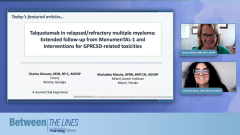
Future Outlooks and Next Steps in Later R/R MM
Panelists discuss that shifting talquetamab dosing from weekly to every 2 weeks improves response durability and patient quality of life, while emphasizing that temporary treatment holds due to adverse effects are manageable, and ongoing research is vital to address unmet needs and advance multiple myeloma care.
Episodes in this series

A major takeaway from recent studies is the shift in dosing schedules from weekly to every 2 weeks for therapies like talquetamab. This adjustment is supported by data showing maintained or improved response rates and extended duration of response. Equally important, the less frequent dosing significantly enhances patients’ quality of life by reducing clinic visits and treatment burden. This change allows patients more flexibility and comfort while still receiving effective therapy.
Another key point is the reassurance clinicians can offer patients about managing adverse effects. It’s essential to emphasize that if treatment is temporarily held due to toxicities, symptoms typically improve, and patients will get through the challenging periods. Having more data available to guide these conversations helps build patient confidence and adherence to therapy. Despite advances, there remains a clear unmet need for additional treatment options in relapsed and refractory cases, as many patients will eventually progress on current therapies.
Looking forward, ongoing research and clinical trials remain crucial. Exploring new combinations and integrating these novel agents earlier in the treatment course are promising strategies aimed at improving long-term outcomes, possibly moving closer to a cure. The field is rapidly evolving, offering hope and more options to patients who previously had limited choices. Overall, continued innovation and clinical investigation will be key drivers in advancing care for patients with multiple myeloma.
Newsletter
Knowledge is power. Don’t miss the most recent breakthroughs in cancer care.





